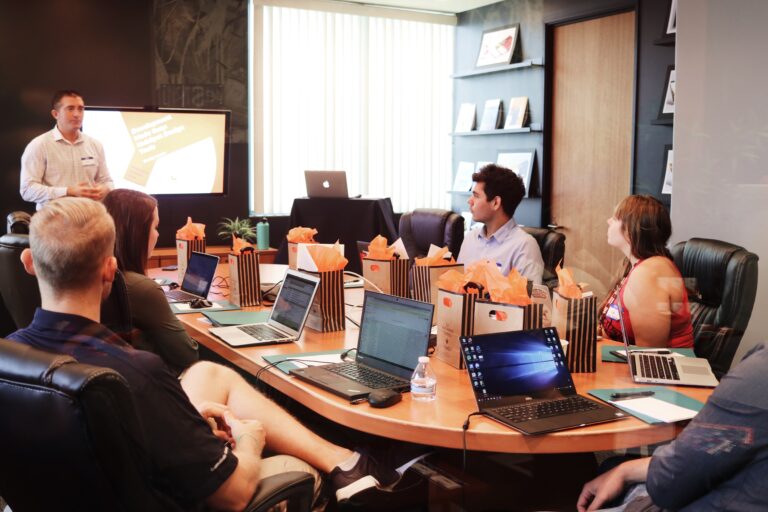Leadership Tips for Guiding Others
Building Rapport, Maintaining the Right Mindset, and Calm Conflict Resolution: Leadership Tips for Guiding Others
In leadership, guiding others requires a delicate balance of rapport building, maintaining the right mindset, and calm conflict resolution. Like a skilled orchestra conductor, influential leaders know how to bring harmony to their teams.
In this article, readers will discover practical tips and strategies to establish a strong foundation with their team, cultivate a resilient mindset, and navigate conflict with calm and empathy. From breathing techniques to negotiation skills, these insights will empower leaders to inspire and confidently guide others.
Establishing a Strong Foundation: Building Rapport With Your Team
The leader builds rapport with their team before challenging times to create a strong foundation for effective collaboration. Building trust is critical in fostering a positive and productive working environment. To achieve this, the leader can employ several strategies.
First, they should actively listen and understand the concerns and roadblocks of team members. This shows they value their input and are willing to address any issues.
Second, effective communication techniques are crucial in improving understanding within the team. Clear and concise communication, active listening, and regular feedback are all important in fostering trust and creating a collaborative atmosphere.
Cultivating a Resilient Mindset: Strategies for Maintaining the Right Mindset
To cultivate a resilient mindset, one must acknowledge worst-case scenarios and develop risk mitigation strategies. Developing resilience requires overcoming negativity and maintaining a positive outlook in facing challenges.
It is essential to recognize that negative thoughts can hinder progress and lead to feelings of despair. By focusing on the most common or likely scenario, individuals can avoid being paralyzed by fear and instead stay present in the problem at hand. Compartmentalizing negative thoughts and staying focused on the present can help maintain the right mindset to handle stressful situations effectively.
It is also crucial to reign in negative thoughts and replace them with more positive and constructive ones. By developing strategies to overcome negativity, individuals can cultivate a resilient mindset and navigate difficulties confidently and confidently.
Breathing Techniques for Calm: Promoting Conflict Resolution
Individuals can reduce anxiety and promote clear thinking for effective conflict resolution using the Wim Hof breathing technique. This technique involves super-saturating the body with oxygen, which helps to calm down and gain control over emotions.
By applying breathing techniques to conflict resolution and problem-solving, individuals can develop insight by reflecting on their contributions to conflicts. It is important to remember moments when others showed grace and apply the same approach to de-escalate conflicts.
Breathing techniques can be powerful in promoting calmness and clarity during conflict resolution. By incorporating these techniques into their approach, individuals can better manage their emotions, listen more effectively, and find constructive solutions to conflicts.
Empathetic Listening: Key to Effective Leadership in Conflict Resolution
Empathetic listening plays a crucial role in effective leadership during conflict resolution. Active listening and fostering empathy are critical components of this skill. When leaders engage in active listening, they demonstrate a genuine interest in understanding the concerns and perspectives of others. This involves giving their full attention, asking clarifying questions, and reflecting on what they have heard.
Navigating Power Dynamics: Negotiation Techniques for Conflict Resolution
Navigating power dynamics requires effective negotiation techniques that allow leaders to find common ground and resolve conflicts. Conflict resolution strategies are essential in managing power dynamics within a team or organization. By employing these strategies, leaders can address and alleviate tensions that arise from differing perspectives and interests.
Power dynamics negotiation involves understanding each party’s underlying motivations and concerns. This insight allows leaders to identify areas of potential compromise and facilitate productive discussions. Through active listening and open communication, leaders can create an environment where individuals feel heard and valued.
Furthermore, leaders must be skilled in managing their emotions and maintaining calm during negotiations. This allows for clear thinking and the ability to de-escalate tense situations. Leaders can approach power dynamics with empathy and a problem-solving mindset to guide their teams toward effective conflict resolution and foster a harmonious work environment.
Supporting Your Team: Alleviating Stress and Providing Emotional Support
To effectively support your team and alleviate stress, providing resources and fostering trust is crucial. By offering the necessary tools and support, you can help your team members navigate challenging situations more easily. This can be done by providing access to relevant information, training, or even external experts who can offer guidance.
Additionally, it is essential to create an environment where trust can flourish. This can be achieved by actively listening to your team members, acknowledging their concerns, and appropriately addressing them. Demonstrating empathy and understanding can build trust and create a safe space for your team members to express their needs and concerns.
Ultimately, providing resources and fostering trust can help your team navigate stress and challenges more effectively.







